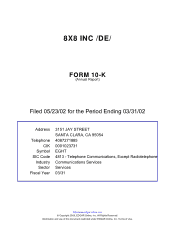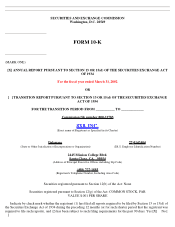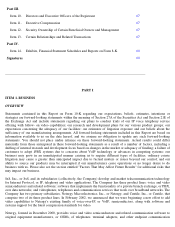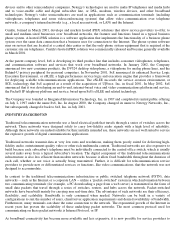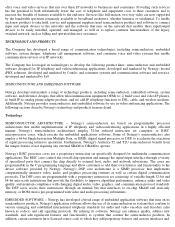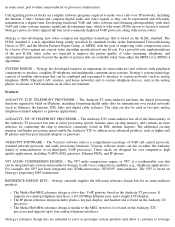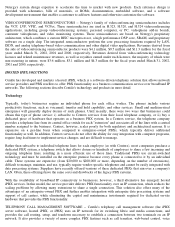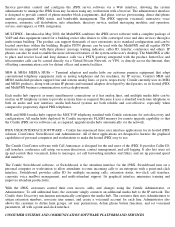8x8 2002 Annual Report Download - page 9
Download and view the complete annual report
Please find page 9 of the 2002 8x8 annual report below. You can navigate through the pages in the report by either clicking on the pages listed below, or by using the keyword search tool below to find specific information within the annual report.message retrieval, and conferencing.
The iPBX software runs on a cluster of carrier-
grade server platforms that are located in a data center. A cluster
typically consists of both active and backup servers. Each active server runs several copies or "instances" of the iPBX
software simultaneously. Each instance is dedicated to a particular enterprise end customer. The server cluster in the
data center is linked to customer sites with a dedicated broadband IP link such as a T1 line. On the customer premise,
terminal adapters or IP telephones are connected to the IP link via an IP router and Ethernet hubs or switches. Terminal
adapters connect standard analog telephones and fax machines to the IP network.
To address scalability and reliability issues, Centile uses a modular and distributed architecture for the iPBX system. In
this architecture, a single instance of the iPBX server software provides complete PBX functionality. A single instance
is designed to support approximately 100 extensions. This limitation minimizes both the processing capacity and
memory requirements of the server platform, allowing less powerful, less expensive servers to be used. Multiple iPBX
instances can be run on each server and larger enterprises can be served by combining instances together to form a
single larger PBX. The system can be scaled in overall capacity by adding more servers.
Much of the flexibility of the iPBX is due to the use of abstraction layers between the core iPBX engine and the
devices with which it interfaces and controls. To allow it to interface to a variety of different telephone sets, PSTN
gateways, and softswitches, the iPBX uses software drivers that support various industry standard and proprietary call
setup and teardown protocols. Currently, the iPBX supports session initiation protocol, or SIP, media gateway control
protocol, or MGCP, H.323v2, and a variety of third-party proprietary protocols.
To allow easy integration with computer programs (computer telephony integration, or CTI), the iPBX supports Sun
Microsystems' Java Telephony Application Program Interface, or JTAPI, version 1.3 for telephony call control. JTAPI
provides an industry standard series of function calls to allow computer programs to control PBXs from more than one
manufacturer. Computer programs interfaced to the PBX might provide a graphical user interface to make it easier to
transfer calls or initiate conference calls, or they might connect a company's customer relationship management
software directly to the phone system, displaying customer information on a computer screen when that customer calls
for support.
The iPBX solution was designed to address the shortcomings of traditional Centrex service offerings in a number of
ways as described below:
1
The use of an IP network allows the iPBX to scale relatively easily and economically because subscribers can
add additional extensions without adding a new cable for each extension. Client devices such as IP phones and
media hubs can be plugged into a company's existing LAN.
1
The iPBX uses an IP network instead of a circuit-switched one so it can be located in the service provider's data
center which may be miles away from the customer enterprise premise and connected to it by only a single
broadband IP link.
1
The redundancies built into the system increase its reliability, particularly when compared to enterprise owned
PBXs.
Products
IPBX SERVER SOFTWARE --
The Centile iPBX server software runs on a cluster of five Sun Microsystems carrier
grade server platforms and provides software PBX functionality over IP networks. The iPBX software was designed
specifically to allow service providers to deliver hosted iPBX services to small and medium-
sized business customers.
The Centile iPBX allows service providers to support up to eighty discrete iPBXs per cluster, each dedicated to an
individual customer, and up to five thousand total extensions.
The server clusters running the iPBX server software are located in a service provider's data center. It is connected to
the customer's premise using any broadband IP connection, though deployments to date have generally utilized a T1
connection. For telephone sets, customers can use terminal adapters to adapt standard analog telephones to IP service or
they can use IP phones. The iPBX server software connects to the PSTN and the long-
distance IP backbone through a
gateway.

